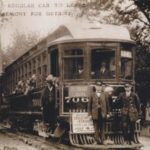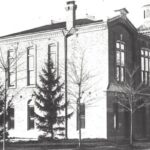On February 22, 1886, Henry Stephens died. He came to Almont in 1845 and began a career in business as a merchant and lumberman. He would eventually be a millionaire. His son, Albert Stephens donated the funds to build the Henry Stephens Memorial Library, now the Almont District Library.
Henry Stephens was born April 14, 1823 in Dublin, Ireland to Robert L. Stephens and Emily O’Brien ( -1823). His mother probably died from the effects of giving birth to him.
When and how he got to America is not known but he probably left Ireland because of the Irish “Potato Famine”. He reached Almont in 1845 and established a store on the east side of South Main Street. The type of store and its exact location are not known.
After six months, he sold the business and moved to Romeo and opened a store. After a period of time, he sold that store and returned to Almont. He opened a store on the northeast corner of the four corners (location of Almont Bakery and Donuts). On September 19, 1853 in Romeo, he married Clarinda J. Leete. They would have two sons: Henry Jr. (1854-1910) and Albert (1857-1926) and a daughter, Sarah Catherine (1862-1898).
In 1855, Ira Goethius built the largest mercantile building ever in Almont, at the corner of Stone and Main Streets (219 S. Main Street – site of old Almont Theater building/Henderson Drugs). William Colerick operated his tinsmith business from the building. The post office was located on a portion of the first floor and the Masons’ hall occupied the second floor.
At a presently unknown date, Stephens and his partner, John Wright bought the building and business and operated a successful hardware and lumber supply business – building known as the “Old Hardware Store”. During the Civil War, the partners cornered the supply of mass-produced cut iron nails for the entire State of Michigan. Iron (wrought) nails produced prior to the Civil War were produced by blacksmiths, one nail at a time, which made them expensive. In the early 1800s, machine made wrought nails reduced the cost but not by much. In the mid-1800s, cut nails could be machine made and drastically reduced the cost. Stephens and Wright built a saw mill at Fish Lake to mill their own lumber from their own land.
Stephens and Wright made a fortune selling nails because as a condition of purchase, the builders were required to buy lumber from the mill at Fish Lake. All of the logging operations for miles around came to the store to buy their saws, shingle mill equipment, and other building supplies. Henry’s brother-in-law, Clare Leete, operated as the clerk of the business. Stephens eventually sold his interest in the business to his partner.
Henry used a portion of the sale of the “Old Hardware Store” to buy the building at the southeast corner of the four corners (now Fountain Park – 101 S. Main Street) from J. S. Jeness. He operated the business as a general store – selling a little bit of everything. He put another brother-in-law, Edward Leete in as clerk and Robert Stewart as bookkeeper. [The building was built in 1855 and destroyed by fire on Super Bowl Sunday in 1992.]
About this time, it appeared that he intended to stay in Almont so he built a large palatial residence on West St. Clair Street at what is now 625 W. St. Clair. However, in 1873, he sold the home to James S. Johnson. The home no longer exists. The sale was probably the result of the financial “Panic of 1873”. He moved the family to Romeo.
Sometime between 1869 and 1872, Henry Stephens, James S. Johnson, Uriel Townsend and Frederick P. Currier agreed to form a company with the intent to develop a tract of lumber that extended from eight mile northeast of Lapeer to Fish Lake. At a cost of $75,000, they would purchase the uncut forest and construct a saw mill.
Uncertainty of the business climate caused Mr. Johnson, Mr. Townsend, and Mr. Currier to want to get out of the enterprise. Mr. Stephens – taking a huge risk – bought them out giving each a good price for their interest in the venture. To do this, he sold the store at the four corners to William Ovens and James Ovens and went entirely into the lumber business.
The “Panic of 1873” almost bankrupted Stephens. However, he rode it out and because of the need for lumber for homes and businesses on the Great Plains, he became a millionaire.
Around the mill at Fish Lake a town of about 275 people developed. Its Post Office was called Stephens. When the stand of pine around Fish Lake was depleted, Stephens moved the operation to St. Helen – again creating a town around the saw mill. The town of Stephens eventually disappeared. Henry’s brother-in-law, James Leete, moved with the company before retiring as Vice-President of the company. He donated the fountain in memory of his wife, Catherine Gutchess Leete, which now stands in Fountain Park.
Henry moved to Detroit to live out the last years of his life. He and Clarinda would spend summers in a home in Romeo which was located just south of the Christian Science Church.
Henry Stephens died on February 2, 1886 while visiting in California. His body was returned to Romeo and he was buried in the Romeo Cemetery on 32-Mile Road. Clarinda Stephens died on February 12, 1919 and was laid to rest next to Henry.
In 1918, Henry’s son, Albert, donated the funds to construct in Almont the Henry Stephens Memorial Library, now the Almont District Library.




